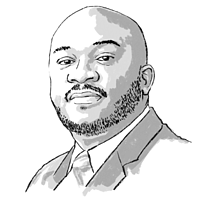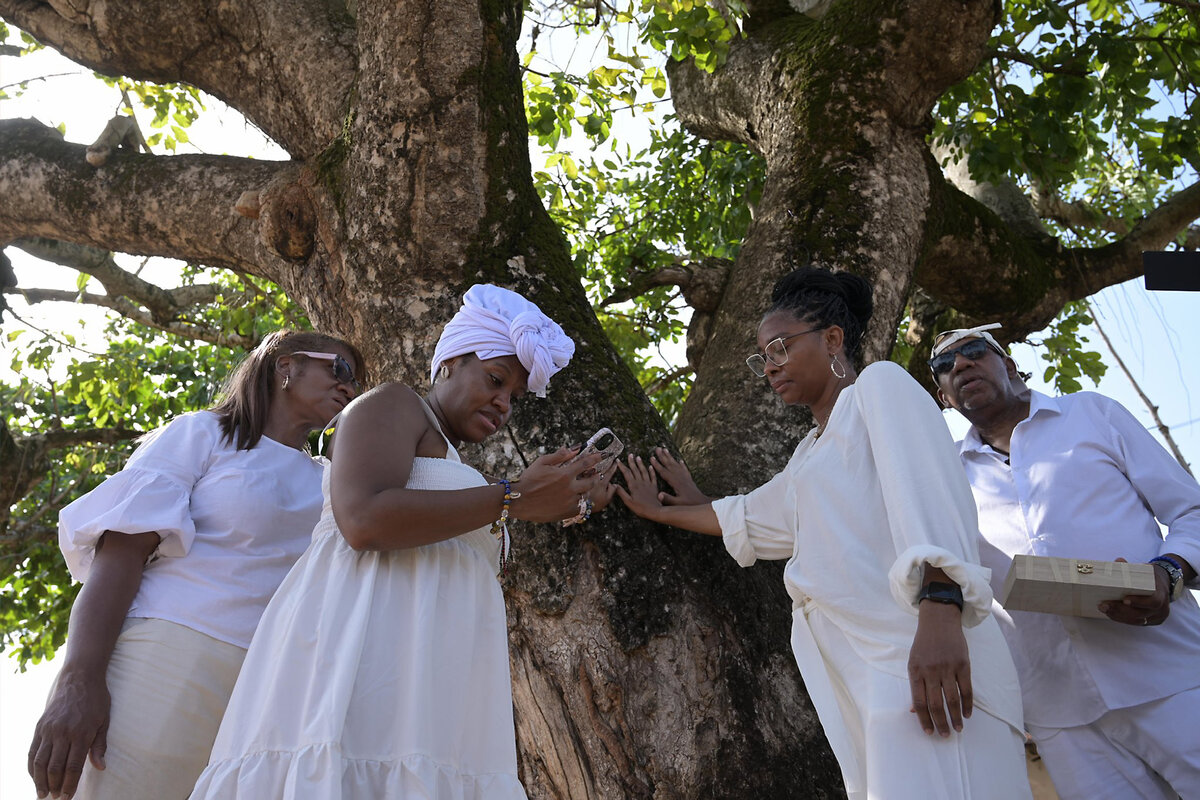They came to the US against their will. Their descendants returned to Africa for them.
Loading...
“America’s last slave ship is more intact than anyone thought,” reads a 2021 headline from National Geographic about the Clotilda. As a new Nat Geo documentary suggests, so are the descendants from that vessel.
In 1860, the schooner Clotilda became the last known ship to carry enslaved people from the west coast of Africa to the United States. In 2019, the ship was found at the bottom of the Mobile River in Alabama. The discovery revived and validated the stories and names of the 110 enslaved people on the ship that had been passed down through generations. The legacy of resistance is present in Africatown, the community they founded after emancipation. It was the vision of Clotilda’s descendants to retain their African history and identity. It is the only community founded by Africans still active in the U.S.
“Clotilda: The Return Home” began streaming on Hulu and Disney+ June 18. The documentary follows the descendants of Cudjoe Lewis and Peter “Gumpa” Lee, two Clotilda survivors, as they fulfill their ancestors’ vision of returning to Africa, which takes them to Benin and the site of the former Dahomey kingdom. Delisha Marshall, a descendant of Gumpa and Josephine Lee, is one of the four individuals featured on the film’s promotional poster.
Why We Wrote This
A story focused onThe last enslaved people to arrive in the United States from Africa tried to get home after they were emancipated. More than 150 years later, their descendants make the journey for them – and consider the legacy they left.
She spoke with the Monitor recently about the documentary, the legacy of the Clotilda, and her ambivalence regarding the return home. The conversation has been edited for clarity and length.
Talk about how you’ve become an ambassador for Clotlida and Africatown.
I really have to give all credit to God on that, honestly. It was all by accident. Participation in the National Geographic documentaries was a product of being in the right place at the right time. I saw an advertisement pop up on Facebook regarding a screening of a documentary about Clotilda at the Nat Geo Museum in D.C., sent a text to my cousins about going, and I happened to be the only one that showed up. After the event, I connected with the lovely Joycelyn Davis [another Clotilda descendant] who’s been doing this work for years. I introduced myself to her and told her I was a descendant of Peter [Gumpa] and Josephine Lee, and a producer overheard me. She was like, “We’ve been looking for someone in your family!” She took my information, contacted me a few weeks later, and the rest is history.
As far as Africatown, I only saw bits and pieces. It still blows my mind to be talking about the community because to me, it was just my parents dropping me off at my grandparents’ house because they had to go to work. When I was growing up, the community was called Plateau. I just thought it was an underserved community. As a child, I wasn’t allowed to leave my grandparents’ yard, so I didn’t get the same experience that my older cousins who lived there did. I had no idea of the history of the community and how it got to its current state until I was grown. But now that I know, I plan to be loud about it. Africatown in its heyday was home to about 12,000 people. Now the population is 2,000, if that. There were thriving Black businesses, but now it’s a food desert. The community is surrounded by various industrial plants ... [and] many residents [have] become sick with illnesses like cancer. There is a major highway running through the center of the community, which reduced some of our family’s land. It’s really sad to see how it started, what it was, and what it is now.
Can you give a summation of the story of Clotilda and Africatown?
To summarize a very long story, what happened around 1859 or 1860, there was a wealthy man by the name of Timothy Meaher. I believe he and his brothers were originally from Massachusetts, but they used to make boats, and ended up moving to Mobile, Alabama. One night, they were drinking, and Meaher makes a bet that he can go to Africa and bring back a boat full of [people]. At this time, slavery wasn’t illegal, but it was illegal to import slaves from other places. Meaher outfitted the ship to make it look like they’re just importing cargo – tobacco, things of that nature. He goes to the coast of West Africa, had negotiations with the King of Dahomey, and ends up purchasing 125 people. But because the importation of slaves is outlawed, and a British warship was out in the water, they ended up leaving 15 people on the shore. So that’s how the 110 got on the boat. I believe it was a six-week voyage, and they made their way back to Alabama. From there, they divided up the people amongst the brothers. ... After emancipation, there were about 32 of them who stayed in the area, banded together, and decided they wanted to try and get back to Africa. They pooled their money in order to do just that, but once they realized that they wouldn’t be able to make it back to Africa, they decided, “Okay, we’re gonna turn this into Africa. We’re gonna make Alabama into Africa.” And they founded this community and called it Africatown.
People are loose with the term “my ancestors’ wildest dreams,” but you’re living that out through your advocacy and research. What does that mean for you, both physically and spiritually?
It’s been a blessing, because what I’m doing is just a continuation of what the Clotilda survivors were doing. They shared their stories with any and everyone who would listen, which is how Cudjo Lewis was able to speak with [author and anthropologist] Zora Neale Hurston. She’d heard their stories and decided to travel to Africatown to document it. And thank God for that, because Cudjo was the one guiding us on this journey back to Benin. He was able to recall where his village was located and the various stops he made along the way before they were put onto the ship. We were able to go back to these places and have conversations due to the map he drew. ... I was able to do burial rites for Gumpa with descendants of King Glele. He [Gumpa] left Dahomey disgraced, since he was given away as a gift by his relatives. But 162 years later, someone from the same family was willing to give him a proper burial. It speaks to redemption, and I hope his soul is at peace now, if it wasn’t before. Sometimes our ancestors start things and it takes time for the things they want to come to pass. In Gumpa’s case, it took six generations for someone in his family to make it back home, but someone finally did.
The more I research I do and find out, the more whole I feel. It’s like putting together pieces of a puzzle. I recently took a trip to California to visit my cousin ... because she is on a whole other level of family research that I aspire to. She was able to tie the family tree back to an African ancestor who came from France in 1795! ... It’s important to note that anyone can do this work. You start with your closest living relatives and just work your way back as far as you can.
Has this experience been wholly positive, or has there been some ambivalence?
Oh, there is definitely ambivalence. When you start digging into the past, you will find out some things that paint relatives in a less flattering light. Take Gumpa, for instance. As cool as it is to say he was a prince, the family he comes from were major players in the Transatlantic slave trade. We still don’t know exactly what he did to fall out of favor with King Glele that would cause him to be given away to Captain Foster as a gift. You find out some family secrets that people either weren’t aware of or didn’t want others to know, so you have to be prepared for that. It makes them human, and you learn to have compassion. I may not like some of the things I find out, but I certainly can’t judge them for it. I wasn’t there and I don’t have all the facts surrounding their situations. ... So as much as you are their wildest dreams, you inherit some of their traumas and nightmares too.
Some people see a conflict between African and American religions. What has that experience been like for you?
I’m still trying to navigate through it. I grew up in the Baptist church and I still enjoy going to church, reading the Bible, and listening to gospel music, but I’m naturally curious. I’m intrigued by African spirituality and learning about the beliefs that my ancestors practiced. I love Jesus, but I love the Orisa too. I like learning about Vodun, which is the religious practice of Dahomey where Gumpa is from. Honestly, it’s confusing and very expensive! But I love the path that I’m on and learning to be patient with it. I was afraid to explore traditional African religions because I thought my family would disown me or certain people would look at me differently, but it’s been the exact opposite. They may not understand it but they don’t love me any less. Once I started learning about Ifa, that’s when certain opportunities surrounding Africatown and the Clotilda started happening, which I don’t think is a coincidence. To me, one is religion, the other is spirituality, and I think they can coexist. I don’t feel the need to choose one or the other. I can do both.
What do you want people to gain from this documentary and from the story of the Clotilda?
To see the survivors of the Clotilda and all enslaved Africans around the diaspora as human. When we study history, we have a tendency to look at people through a certain lens, but they are just that: people. They were griots [storytellers and musicians], chiefs, priests, artists, dancers, fathers, daughters, wives, husbands. One of my ancestors just happened to be a prince. They were fully realized human beings just living their lives before they fell victim to the international slave trade. Everyone wants to have a good life – prosperous communities, strong family ties, happy and healthy children, and to exist authentically. We all have that in common. ... And that was the point of founding Africatown. The survivors weren’t accepted by the African American community in Mobile, so they created their own, where they could educate their children, practice their beliefs, and have the freedom to live their lives as they saw fit.








